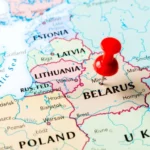Russia has increased its adoption of the Chinese currency, renminbi, as one of the primary currencies for its international reserves, trade and some personal banking services, as it turns towards China amid western sanctions.
This move has made Russia a rare example of a country adopting renminbi instead of the US dollar or euro as a reserve currency. However, it poses risks for Russia due to China’s history of abrupt currency devaluations.
The desire for the international adoption of the renminbi has largely been unfulfilled, but Russia has been driven towards the Chinese currency due to international sanctions, the freezing of its $300bn international assets and attempts to exclude its primary banks from global markets.
Russia was the fourth-largest economy, excluding Hong Kong, for volumes of renminbi trading in February 2023, according to data from the Swift global payments system. It did not feature in the top 15 before Russia’s full-scale invasion of Ukraine. The rise of renminbi trading mirrors Russia’s economic pivot to China, with bilateral trade hitting a record of $185bn in 2022.
Russian companies pay for most purchases of Chinese goods in renminbi, purchases that increased sharply after the invasion of Ukraine.
Before the invasion, more than 60% of Russia’s payments for its exports were made in what the country’s authorities now refer to as “toxic currencies” such as the US dollar and euro, with renminbi accounting for less than 1%. Now, toxic currencies have dropped to less than half of export payments, while renminbi accounts for 16%, according to data from the Central Bank of Russia (CBR).
President Vladimir Putin endorsed the broader international use of the renminbi in March 2023, stating that he supported “the use of the yuan in payments between Russia and countries of Asia, Africa, and Latin America”.
More Russian banks adopt China’s currency
More than 50 Russian banks now offer renminbi-denominated deposits, often under names like “Silk Way” and “Crescent Moon,” attracting ordinary people with interest rates higher than US dollar-denominated accounts. Russians are already accustomed to holding savings in dollars or euros after experiencing the abrupt devaluation of the rouble in the 1990s.
However, Victoria Shergina, a financial adviser with more than 800,000 Instagram followers, said, “When the rouble strengthened last summer, people panicked. ‘Is it true that the US dollar and the US are dead?’ they asked, repeating the state narrative. ‘Do I need to get rid of my savings in US dollars immediately?’”
The central bank began switching to renminbi even before the full-scale invasion of Ukraine, increasing its share from 13% to over 17% of its currency reserves in the year to January 2022 when it disclosed details of its currency reserves structure for the last time.
The figure has likely remained unchanged, given that the central bank did not increase its reserves in 2022. It did not sell gold, which it could have used to buy renminbi, while its euro and dollar holdings were frozen, said Alexandra Prokopenko, a former CBR adviser and now a visiting fellow at the German Council of Foreign Relations.
Russia’s adoption of the renminbi as one of its main currencies has primarily been driven by the need to diversify its currency reserves, particularly amid rising western sanctions, which have led to the freezing of its assets in dollars and euros. The country has sought to reduce its reliance on the US dollar and euro, particularly given the risk that western sanctions could further curtail its access to those currencies. According to experts, this move is also aimed at reducing the risks associated with keeping a substantial portion of its reserves in what it considers toxic currencies.
The shift towards the renminbi has not come without risks for Russia. China has a history of abrupt currency devaluations, which could negatively impact Russia’s holdings if the renminbi were to suddenly lose value. Additionally, Russia’s increased reliance on China could lead to potential political and economic vulnerabilities. However, given the economic and political pressures Russia is facing from Western sanctions, the benefits of diversifying its reserves and trade partnerships seem to outweigh the risks.
Further reliance on China?
Furthermore, the adoption of the renminbi could also strengthen Russia’s economic ties with China, which have already been growing steadily in recent years. Bilateral trade between the two countries hit a record of $185 billion in 2022, and Russian companies are increasingly paying for their purchases of Chinese goods in renminbi. This shift away from so-called “toxic currencies” like the US dollar and euro has been encouraged by the Russian government in response to international sanctions.
The trend towards using the renminbi is not limited to the Russian government and businesses, however. Ordinary Russian citizens are also increasingly investing in renminbi-denominated deposits, often attracted by higher interest rates compared to US dollar accounts. More than 50 Russian banks now offer renminbi-denominated deposits under names like “Silk Way” and “Crescent Moon.” This shift is especially notable given that Russians have traditionally held their savings in US dollars or euros, following the rouble’s abrupt devaluation in the 1990s.
Despite some potential risks, Russia’s adoption of the renminbi reflects the country’s growing reliance on China as a key trade partner and a potential ally against Western sanctions. The move also reflects China’s ongoing efforts to increase the international adoption of the renminbi, which has largely gone unfulfilled so far.
As China continues to push for greater global acceptance of its currency, it remains to be seen whether other countries will follow Russia’s lead in adopting the renminbi for their reserves and trade transactions.

















